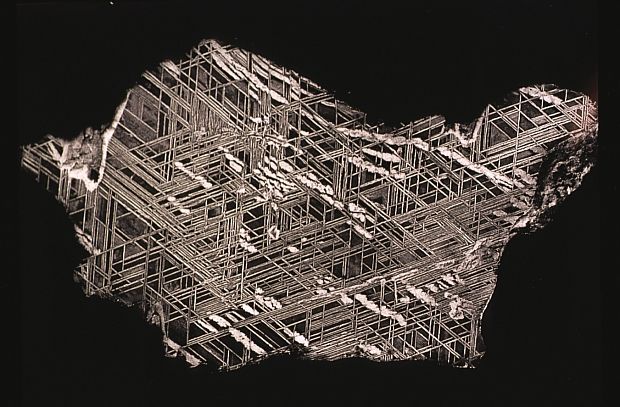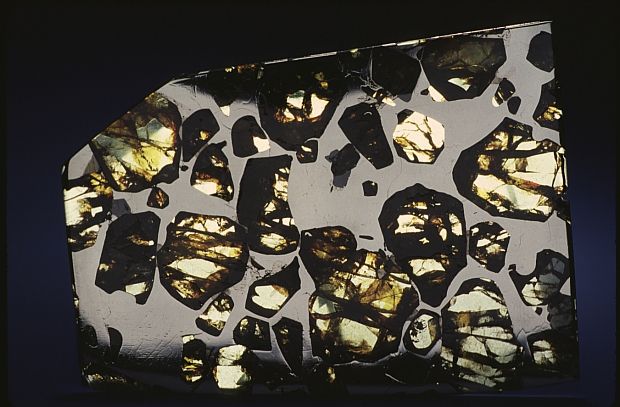Meteorite Minerals
What is a meteorite?
Meteorites are fragments of rock that fall to the surface of Earth from outer space, having been captured by Earth's gravitational pull. Many originated during the widespread violent collisions between the inner planets and asteroids that were a prominent feature of the early Solar System. Such impacts may blast areas of a planet's surface back out into space, only to be recaptured by another planet billions of years later. Thus, some of them are compositionally identical to moon-rocks, some have been interpreted as originating on Mars, while still others, made mostly of iron and nickel, are believed to represent core material from some long-disintegrated planetoid.
Much material enters Earth's atmosphere from space every day, from both natural and manmade (so-called Space Junk) sources. Most of it is of a small size and burns up during its descent through the atmosphere as the familiar shooting stars. However, larger bodies can and do reach the surface: these highly noticeable events are accompanied by bright fireballs, sonic booms and explosions.
Meteorites are classified by their compositions and textures, the latter only being appreciated by cutting and polishing a specimen to reveal its internal structure. The chief division is between stony, iron, and stony iron meteorites:
Stony meteorites
These are meteorites dominated by silicate rock-forming minerals. They are divided into two chief classes. Firstly there are the chondrites, which contain small mineral spheroids (chondrules) plus iron and other metallic minerals, and represent over 80% of meteorite falls. Secondly, achondrites are simply stony meteorites without chondrules: it is believed that some of these meteorites, which make up less than 8% of recorded falls, originated on the surface of the Moon or Mars. They consist chiefly of basaltic or gabbroic rock.
Iron meteorites
Iron meteorites consist of a crystalline iron-nickel alloy, together with various sulphides, phosphides and carbides. It is believed that they are made of similar material to the outer core of the Earth. Only 4.8% of meteorite falls consist of irons, and they are subdivided into three major classes: firstly the hexahedrites (<6% Ni), secondly the octahedrites (6%-17% Ni) and thirdly the ataxites (>17% Ni). Of these perhaps the best known are the octahedrites, which consist of a crystalline intergrowth of the Fe-Ni alloys kamacite and taenite, revealed on etched polished surfaces by the attractive Widmanstatten texture. This is indicative of very slow crystallization during prolonged cooling – a process thought to have taken place deep within a former planetary body.

Polished slice of an Octahedrite iron meteorite, that has been etched with acids to show the Widmanstatten structure (crystalline intergrowth of the two Fe-Ni alloys, kamacite and taenite). © Smithsonian Institution.
Stony Iron meteorites
These consist of a mixture of iron-nickel alloys and non-metallic minerals and constitute 1.2% of meteorite falls. They are subdivided into pallasites (olivine in a nickel-iron matrix) and mesosiderites (intergrown silicates and metal grains). Pallasites are thought to have formed at the core-mantle boundary of a former planetoid, while mesosiderites are belived to have formed by accretion during violent asteroid collisions.

Polished slice of a Pallasite iron meteorite, consisting of Fe-Ni alloy and golden olivine crystals. A well-travelled chunk of the disintegrated core of some ancient planetoid. © Smithsonian Institution.
Meteorite falls recorded in Wales
There are only two well-documented meteorite falls in Wales, in 1931 and 1949: however, it is statistically likely that many other falls have occurred but gone undetected in sparsely-populated areas. Details of the two well-documented cases are given below.
Pontllyfni, Gwynedd, 1931:
A stony meteorite, compositionally a forsterite chondrite with 46 wt % sulphides and metals (Graham et al., 1977), fell in daylight on April 14th, 1931 at 11:53am. Although a fragment weighing 5 oz (141.7 g) was recovered, the main mass of what was a substantial bolide probably fell into the sea. The first report reproduced here relates to the bolide overflying England and Wales and gives some idea of its size. It was originally printed in the Yorkshire Post, dated April 15, 1931, and was quoted by King (1932):
‘There was a terrific double report followed by an awe-inspiring rumble of earth lasting quite 30 seconds. The rumble shook the houses and left an eerie feeling, especially to the residents of houses on elevations. People had their fears intensified by the affrighting effect of the disturbance on domestic animals and on birds and cattle. . . . The effect of the tremor on Portmadoc and neighbouring towns and villages was immediately to empty houses and business premises of their occupants. The streets were crowded with people, whose anxiety was intensified by memory of a terrific explosion during the Great War at a neighbouring explosives factory. Others suggested an explosion in North Wales quarries. Inquiries dissipated these notions. The alarm subsided slowly, and all day the inhabitants were discussing what could have caused the terrifying report and equally terrifying tremor. . . ‘.
The second report was also quoted by King (1932) and is an abridged extract from the Manchester Guardian:
‘The meteorite fell within 50 yards of the farmhouse. Weight, exactly 5 oz. lt made a hole 8 in. or 9 in. deep in very hard ground. Mr. John Lloyd Jones (tenant of Coch-y-Bug) was not more than ten paces from the spot when it came down. He was startled shortly before noon by what he took to be a clap of thunder. He walked 200 yards towards the farm-buildings, when he heard a 'rushing, whistling sound.' 'I stood still,' he added. 'and shouted to my son, and then behind me I heard a dull thud. Not knowing what was going to happen, I ran a few steps towards one of the outbuildings. Then my son came up and he took out of a hole in the ground what seemed to be a stone.' Mr. John Aneurin Jones, a son of the house, said: 'I heard a succession of reports like muffled guns, and about a minute later there was a peculiar whistling noise as of a projectile. Instinctively I stooped where I stood in the farmyard. When I picked up the fragment of metal, or whatever it is, it was warm in my hand.' Just before the meteorite fell, he added, horses which were being led reared and whinnied and seemed rather affrighted. Their disorder continued till after the occurrence, when they quietened down.’
Beddgelert, Gwynedd, 1949:
A stony meteorite, compositionally an iron-rich chondrite, fell on September 21st, 1949 at 1:47am. A mass weighing 794 g fell through the roof of an hotel! The following extracted account was printed in Nature, December 10th, 1949:
‘The Trustees of the British Museum (Natural History) have acquired, partly by purchase and partly by presentation, from Mrs Lorna Tillotson, one half of a new meteorite which fell at Beddgelert, Caernarvonshire, on September 21. The other half is to go to the University of Durham, where Prof. F. A. Paneth plans to make measurements of the helium, uranium and thorium content to add to the present meagre data available for calculating the age of meteoritc stones. Plaster casts of the stone will be made before it is divided. The meteorite is a black chondrite, a rather uncommon type of stony meteorite. The mineral composition has not been studied at present. Its arrival was accompanied by several loud explosions likened by Mr. Tillotson to heavy gunfire. Mr. Tillotson, by noting the positions of the holes in the roof and in the ceiling of the room into which the meteorite fell, determined that the angle of its fall on the roof was nearly vertical.’
References:
Graham, A.L., Easton, A.J. & Hutchison, R. 1977: Forsterite chondrites; the meterorites Kakangari, Mount Morris ( Wisconsin), Pontlyfni, and Winona. Mineralogical Magazine, 41, 201-210.
King, A. 1932: The meteorite of 1931 April 14. Journal of the British Astronomical Association vol 42, 328-332.
